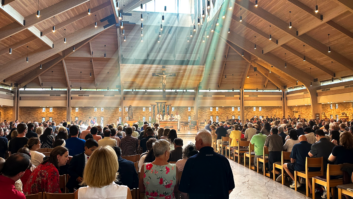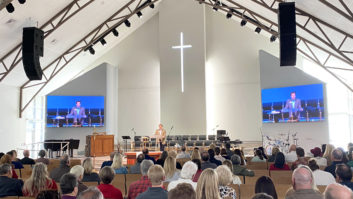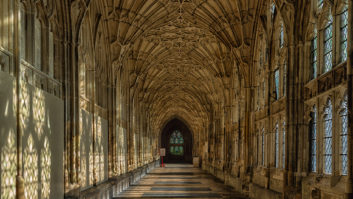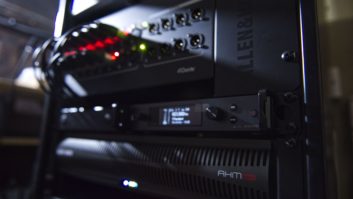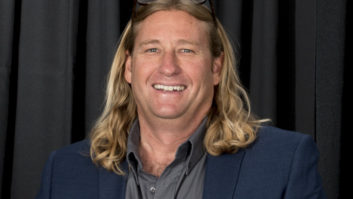For the second time in a year, multiples of JBL’s discreet Control 52 satellite speakers have been installed under the pews of one of the UK’s most historic college chapels.
Following the installation of 127 of these miniature speakers at the 16th century Trinity College, Cambridge, back in February, a similar solution has been provided at the famous New College Oxford chapel, which dates back to 1379, when it was founded by William of Wykeham, Bishop of Winchester.
The latest contract was fulfilled by classical recording specialists About Sound and also includes devices from fellow Harman brands Crown, BSS Audio and AKG. All Harman Professional components were supplied by Sound Technology, exclusive UK and ROI distributors.@page_break@
Working alongside the Chapel’s musical director, Professor Edward Higginbottom, and chaplain Reverend Dr Erica Longfellow, they were initially drafted in to set up a recording facility for the College’s famous choir, enabling services of choral evensong to be webcast on a weekly basis.
About Sound’s appointment was based on their pedigree — and particularly the work they had carried out earlier at St. John’s College Cambridge, where they provided a similar set-up for their own world-famous choir.
It was during the second phase of work at New College that the issue of amplifying the spoken word was broached. “The College had been spending a fortune on rental PA for the larger events,” says About Sound’s technical manager Richard Bland. “To have speakers on sticks brought in to a building as eminent as this was not aesthetically ideal and the sound couldn’t be described as intimate or discreet.”@page_break@
Aware of how successfully the JBL Control 52s had been integrated at Trinity College, About Sound MD Matthew Dilley arranged for two Control 52s to be demonstrated to the Chaplain. In the resulting design, around 100 JBL satellite speakers have been locked onto a custom bracket and mounted behind the pews on oak-stained plywood. Richard Bland also knew that by deploying large quantities of the Control 52s they could be driven at a much lower volume level. “It gives an almost mystical effect,” he says.
These are processed and controlled within a BSS Soundweb London digital processing environment, comprising a BLU 100, with a fixed configuration of 12 inputs and 8 outputs, two BLU-BOB breakout boxes providing necessary output expansion and BLU-8 wall-mount controller for selecting basic presets. Meanwhile, a custom touchscreen interface was designed around a Windows 7 wireless tablet PC for more complex control from any location.
Each of the four lecterns has an LED button sunk into the pew. Richard Bland has set up sequential delay times so that when a speaking position is selected, the speaker delays are adjusted accordingly so that the natural voice arrives fractionally before the amplified sound. This orientates the listener to where the speech is coming from and ensures that the voice of the speaker is first at the local position.
The system is designed to be moderated by the buttons for straightforward services, with the touchscreen giving access to more complex features, such as defining the position from which radio microphones are being used, for the more involved services.
The building’s three sections — the ante chapel, choir stalls and altar — are assigned to 16 sound zones (plus hearing loop), with the speakers driven 100V line from a pair of Crown’s CT8150 1U 8-channel power amplifiers (using DriveCore technology) and a CTs1200, which powers two JBL CBT100 column speakers in the ante chapel and two CBT 50s discreetly set at the altar.
The CT8150s were selected because of the 90% efficiency in the DriveCore stage, and the fact that no fan is required, resulting in ultra-quiet operation (which was essential). About Sound also liked the compactness of the amplifiers, allowing for the drive racks to be positioned snugly in the organ loft alongside the recording set-up.@page_break@
A number of task-specific microphones have been selected, with AKG C747 miniature shotgun mics (with shockmount/adapters) fixed at the lectern positions and an AKG GN 155 Set Gooseneck Podium Mic positioned in the altar area.
But it is provision of the AKG DMS 700 digital wireless system (three bodypack transmitters and one handheld) that makes the officiating clergy’s task so easy. This, according to Matthew Dilley, offers a great solution. “With its wide tunable bandwidth you don’t have to commit to frequencies at the specifying stage. In addition, the recharging cradles eliminate battery management issues and the remote mute switches, worn on the sleeve, give the clergy easy access to their mute function without having to delve in their cassock pockets.”
Richard Bland says that the sound is now better articulated with a much higher degree of intelligibility, directionality and imaging. About Sound can reflect on a challenging installation, accomplished with a high degree of sensitivity in this Grade I-listed building.

